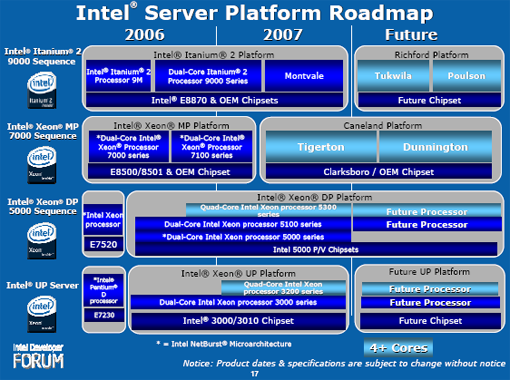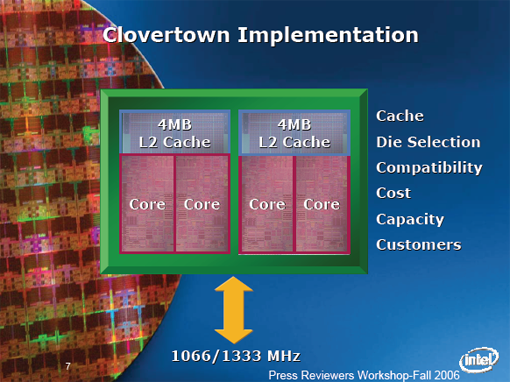Intel Clovertown: Quad Core for the Masses
by Jason Clark & Ross Whitehead on March 30, 2007 12:15 AM EST- Posted in
- IT Computing
Architecture & Roadmap
It's no secret that Clovertown isn't what the purists would call a "true quad core" architecture; it is two Woodcrest processors joined together in a single package. Does it matter? In our opinion, no. Clovertown performs very well, as you will see later in the article.
Clovertown is going to be with us for most of 2007 until Penryn is released, which is essentially a die shrink to 45nm. It is doubtful we will see a "true" quad core Intel part until the next generation architecture is released in 2008, code-named Nehalem. Below is the most recent server roadmap we have for the server platform. The part marked "Future Processor" in the Xeon DP Platform and UP Platform is Nehalem. You can read more about Nehalem and Penryn in our recent article on that subject.

Clovertown at its heart is two Woodcrest parts connected together on a single package. Each pair of cores shares a single 4MB of L2 Cache, just like Woodcrest and the pair of cores shares a single 1066/1333 MHz pipe. For most Woodcrest systems, Clovertown will be a drop-in replacement after a BIOS upgrade. We tested the Clovertown in a spare Supermicro board we had in the lab, and had no issues upgrading it from dual core to quad core. For a more in-depth analysis of Clovertown architecture, check out a Johan's very thorough write-up on Clovertown.

It's no secret that Clovertown isn't what the purists would call a "true quad core" architecture; it is two Woodcrest processors joined together in a single package. Does it matter? In our opinion, no. Clovertown performs very well, as you will see later in the article.
Clovertown is going to be with us for most of 2007 until Penryn is released, which is essentially a die shrink to 45nm. It is doubtful we will see a "true" quad core Intel part until the next generation architecture is released in 2008, code-named Nehalem. Below is the most recent server roadmap we have for the server platform. The part marked "Future Processor" in the Xeon DP Platform and UP Platform is Nehalem. You can read more about Nehalem and Penryn in our recent article on that subject.

Clovertown at its heart is two Woodcrest parts connected together on a single package. Each pair of cores shares a single 4MB of L2 Cache, just like Woodcrest and the pair of cores shares a single 1066/1333 MHz pipe. For most Woodcrest systems, Clovertown will be a drop-in replacement after a BIOS upgrade. We tested the Clovertown in a spare Supermicro board we had in the lab, and had no issues upgrading it from dual core to quad core. For a more in-depth analysis of Clovertown architecture, check out a Johan's very thorough write-up on Clovertown.











56 Comments
View All Comments
Visual - Friday, March 30, 2007 - link
the two xeon sockets share a common fsb to memory and io bus, right?perhaps you should have included a 1-socket xeon vs 2-socket opteron, just to see how they compare when the xeons aren't as starved for bandwidth... not necessarily a 775 xeon and mobo, i imagine the 771 systems you used now would run just fine with just one of the cpu-s.
sure, that would turn into a core 2 extreme quadcore vs amd 4x4, or their server equivalents running server benchmarks instead of games but i'm still curious about it :p
JarredWalton - Friday, March 30, 2007 - link
I believe (could be wrong - it might be a future chipset; can't say I'm up-to-date on the server chipsets these days) that the Xeons have a Dual Independent Bus configuration, so they do get double the bandwidth. The only truly fair way of comparing would be a quad core AMD chip against a quad core Intel chip, but we obviously have to wait on AMD there. It's certainly going to be an interesting matchup later this year.Note that in 2008, Intel will use a quad bus topology similar to HyperTransport, at least on paper, so they are certainly aware of the bus bandwidth problems right now. I'm not sure FB-DIMMs are really helping matters either unless you use huge memory footprints. So FB-DIMMs can be good in the real world but bad for benchmarks that don't utilize all the available RAM.
DigitalFreak - Friday, March 30, 2007 - link
FB-DIMMs are also un-godly expensive if you need to have 16+ GB in a 2U box. With the Opteron boxes, you tend to have many more DIMM slots, so you can use lower capacity DIMMs.yyrkoon - Friday, March 30, 2007 - link
I thought my eyes were decieving me, so I had to go back and look at the charts. AMD CPUs are capable or more transactions per second ? Wow. Granted, AMD CPUs also seem to use more power, but they also seem to have a 'better' CPU usage curve.I suppose most companies, and enterprises would probably opt for the intel, based on long term power savings, and probably have an Opteron machine or two, where performance was critical.
It is nice to know, that AMD still does something better than intel. Makes me feel better about buying an Opteron 1210 for my desktop, even if it isnt a socket F Opteron . . .
Phynaz - Friday, March 30, 2007 - link
No.
The tested SYSTEM is capable of more transactions per second.
defter - Friday, March 30, 2007 - link
You mean that four top of the line AMD cpus were outperforming two second fastest Intel's CPUs?Clovertown's performance is very impressive, since according to those results two top of the line 2.66GHz Clowertowns would match performance of four 2.8GHz Opteron.
Viditor - Friday, March 30, 2007 - link
It may be less impressive than you think as 4 dual core 2.4GHz Opterons beat 2 quad core 2.33GHz Clovertowns (by 16%).
JarredWalton - Friday, March 30, 2007 - link
I'm not sure where you get that comparison. Four dual core 2.8 GHz Opterons beat two 2.33 GHz Clovertown by 16% - in certain situations.Viditor - Friday, March 30, 2007 - link
If you scroll up a few posts in this thread, you'll see the quote and link...
"...Two 2.4GHz Opteron 880 processors are as fast as one Xeon 5345, but four Opterons outperform the dual quad core Xeon by 16%..."
JarredWalton - Friday, March 30, 2007 - link
Ah, right. I think that's part of what Ross was talking about when he discusses the difficulties in coming up with appropriates tests for these systems. The Forum and Dell Store benchmarks had some serious issues, likely related to optimizations and I/O activity. There are instances where Intel does better, and of course others where they do worse.